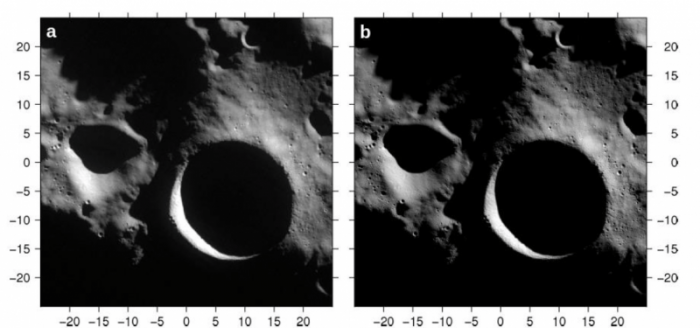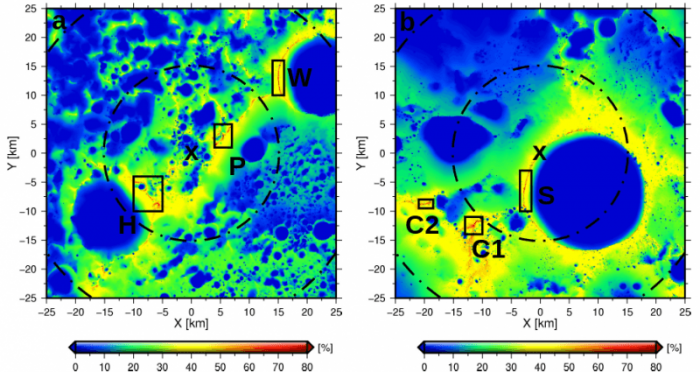
The 23.4° tilt of the Earth’s rotation axis with respect to the ecliptic plane is the reason for our pronounced seasons on Earth. The ecliptic plane itself is defined by Earth’s orbit around the Sun. Contrary to Earth the lunar spin axis is almost perpendicular (1.5°) to that plane leaving the Moon with no distinct seasons.
Near the lunar poles, however, this small tilt has a major effect. If you were standing right at the pole you would observe the Sun moving from East to West with elevations ranging from only -1.5° to 1.5°, depending on the season. That means that over the course of a year the Sun is always very close to the horizon. For example, if you were standing high up on a mountain you could, in theory, continuously see the Sun, and conversely never see the Sun if you are down in a valley.
Scientists were already thinking exactly about that fact 60 years ago! They predicted that due to the low solar elevation near the poles, crater floors that reside in permanent shadow but also hills that reside in eternal light should exist. Further, they claimed that due to the lack of sunshine such cold temperatures are present in permanently shadowed craters that surficial water-ice could accumulate. Thanks to the newest high-resolution data from NASA’s Lunar Reconnaissance Orbiter (LRO) permanently shadowed areas could be located and mapped. Unfortunately, no points of eternal light exist but many very promising crater rims were identified that offer long periods of illumination.
In our study ‘Illumination conditions at the lunar poles: Implications for future exploration’ published in the journal Planetary and Space Science, we were able to identify those hypothesized near polar areas with long periods of illumination and which are located close to craters whose floors are permanently shadowed. Data from the Lunar Orbiter Laser Altimeter (LOLA), one of the six instruments on-board LRO, was used to create Digital Terrain Models (DTMs) of the lunar poles with a resolution of 20 meters per pixel. We wrote software that synthetically illuminates our DTMs based on the orbital position of the Moon wrt the Sun (Fig. 1).

Figure 1: (a) An image of the lunar south pole taken October 8th, 2011 by the Wide Angle Camera of the Lunar Reconnaissance Orbiter. (b): Our DTM which was synthetically illuminated at the exact same time as when the image (a) was taken. Even small-scale features are illuminated properly, e.g. lower right corner, and overall no differences between the image and the simulation are visible. Credit: Philipp Gläser
In total, we illuminated our DTMs over a 19-year period with a step size of one hour, leaving us with about 170,000 snapshots of the synthetically illuminated surface. The figure below (Fig. 2) shows a so-called accumulated or average illumination map of all those snapshots revealing which pixel is illuminated for how long. Note that Fig. 1b is one of the 170,000 snapshots that entered in the averaging for Fig. 2b and shows the exact same area around the south pole.

Figure 2: The average illumination maps of the north (a) and south (b) pole. (a) We identified three areas with high illumination levels at the crater rims of Hinshelwood, Peary and Whipple Crater. (b) At the south pole, we found one area located on Shackleton’s crater rim and two more on a ridge from Shackleton towards de Gerlache crater. Reprinted from Publication Illumination conditions at the lunar poles: Implications for future exploration, Volume 162, P. Gläser, J. Oberst, G.A. Neumann, E. Mazarico, E.J. Speyerer, M.S. Robinson, Pages 170-178, Copyright (2018), with permission from Elsevier
At the north pole we found that the Sun is visible 88.5% of the time at Whipple’s crater rim (denoted W in Fig. 2a)and at the south pole we found Shackleton’s crater rim (denoted S in Fig. 2b) to be in the Sun for 85.5% of the time. In other words, the Sun, on average, can be seen around 320 entire days (day+night) each year. We also found that if we would place a solar panel at 2 meters height above ground, that this tiny little change in altitude makes a big difference. At the north polar Whipple crater such a panel would be in the Sun 90.8% and at the south pole along the ridge (denoted C1 in Fig.2b) even 92.1% of the time, hence a total of 336 full days of sunshine each year! Any further change in altitude does not have such a big effect on illumination anymore and a structure with a solar panel at 2 meters above ground also seems more realistic than at 50 meters or more where constant illumination might be reached.
We argue that a successful landing at one of these areas would allow for an almost constant power supply using solar arrays at 2 meters height while offering the opportunity to explore nearby water-ice bearing crater floors. The nearby reservoirs of water-ice could be used for drinking water recovery for manned missions but also for rocket fuel production. In the long run, such landing spots could serve as an interplanetary gas station for deeper exploration of our solar system and beyond.
These findings are described in the article entitled Illumination conditions at the lunar poles: Implications for future exploration, recently published in the journal Planetary and Space Science. This work was conducted by P. Gläser from the Technische Universität Berlin, J. Oberst from the Technische Universität Berlin, German Aerospace Center, and Moscow State University for Geodesy and Cartography, G.A. Neumann and E. Mazarico from NASA Goddard Space Flight Center, and E.J. Speyerer and M.S. Robinson from Arizona State University.
- Reprinted from Publication Illumination conditions at the lunar poles: Implications for future exploration, Volume 162, P. Gläser, J. Oberst, G.A. Neumann, E. Mazarico, E.J. Speyerer, M.S. Robinson, Pages 170-178, Copyright (2018), with permission from Elsevier









